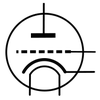so1om

Joined: May 10, 2012
Posts: 492
|

Posted on Feb 09 2013 04:57 PM
Ok.. so we all know the "debate" about buzzing bridges, Mastery, Mustang, etc..
I was at Chicago Music Exchange this afternoon and I took a good hard look at vintage Jaguars/Jazzmasters, some of the CP and AVRI and a few of the Squiers.
The finishing details of the bridge on the vintage and say the 50th Anny Jaguar: Clean well-finished, deburred edges and chamfers. The screws are also clean and they have what appears to be a bright zinc finish -it could be a different grade of chrome as well. It's really hard to say as finishing processes have come a long way in the last 50 years.
The Squier (I own a Jaguar model): Again, the edges are clean, you won't snag the palm of your hand or cuff or anything, but for those that work in metal and machining, it appears they have a looser tolerance for what they accept on the machining and finishing. The chamfers and lead ins for the set screws, etc. Plus the allowance for finish build up. It would appear that the set screwss have a looser fit as well
Remember they have to have make the threads, for the screw and for where it threads in (the saddle). Then they have to consider the flash of metal they have to put on before they put on the flash of chrome finish. High quality, expensive parts -they can allow a tighter fit, a lower yield for a given lot of parts, and a higher cost per part.
I think what a lot of us are seeing in the Squier VM line are the looser fit parts. As a result, we are experiencing more buzzes, rattles, screws that seem to fall out, etc. That is not to say the design is bad or that it cannot be overcome. All it takes is a little patience and time to take care of those things.
Perhaps someone has a Squier and a vintage where we could see side by side pics?
|
eddiekatcher

Joined: Mar 14, 2006
Posts: 2779
Atlanta, GA





|

Posted on Feb 09 2013 07:48 PM
From an engineering perspecive it has to do with inteference fit and percentage of thread depth. I think Leo knew something that Fender has since forgotten. The original offsets did not have plated bridge saddles or adjusting screws. My number one AVRI Jazzmaster came from the first batch and I noticed the sloppy tolerances in the bridge adjustment immediately.
However, I have never seen one of these guitars that could not be adjusted for the bridge to work really well, it just takes some effort. Here we go again.
A few tips:
Use big strings.
Run the outside bridge saddles to their approximately highest height adjustment point, adjustment screws flush with the top of the saddle.
Now shim the neck to increase the string angle break over the saddles.
Initially adjust the two master bridge height screws to dial in the height adjustment you want for your set up using the two outside strings/saddles as a guide.
Now adjust the four inside strings.
Because of the fingerboard radius, none of the bridge saddle adjustment screws should protrude above saddles (nice smooth palm muting)
Now tweak........happy?
Now locktite the underside of all the bridge screws. I put a dab between the bridge saddles as well to benefit from combined mass and prevent side to side vibration AFTER I'm sure I have the intonation where I want it.
Play on.........nice happy guitar.
You need to re-adjust something? Heat up the bridge in the oven or use a high wattage soldering iron. Replacing the stock screws with stainless is a hip idea. McMaster Carr has them but you have to spring for a whole box. You can shorten them using a Dremel tool or shop grinder. So one size can fit all.
Or you can go fire up the lathe and machine your own custom saddles. "Free machining brass" works well and threads easily. Stainless is too much of a pain in the ass. Been there and done that.
Eddie K
— Traditional........speak softly and play through a big blonde amp. Did I mention that I still like big blonde amps?
|
so1om

Joined: May 10, 2012
Posts: 492
|

Posted on Feb 10 2013 12:35 AM
Well.. I don't know where to begin. I was only referring to where buzzing and rattling occurs with respect to vintage and, say, the 50th anny and the Squier. There is MORE than enough engagement, it's irrelevent. It has to do with the tolerance stackup of fit and finish and i mentioned.
I string all my guitars with Super Slinkies .009s,never a problem. I can disregard the rest of the adjustments you mention. It is a way of getting there, but I wouldn't remove the neck and shim it unless I couldn't do with how it is already.
The use of loctite underneath the screw is incorrect. It may work, but it has to flow and be around all the threads and along the screw's length for it to be most effective. Gluing the pieces, well that sounds unnecessary. And if you want to loosen it, just use the loctite solvent. You should only be using purple or blue anyway. You heat up the springs, they'll anneal and soften too.
As long as you're ordering from McMaster, just get set screws with the nylon patch on them. I've had good luck with the mil-spec screws and certain other bridges too.
and here: http://surfguitar101.com/forums/topic/20556/
|
JakeDobner

Joined: Feb 26, 2006
Posts: 12159
Seattle



|

Posted on Feb 10 2013 12:55 AM
eddiekatcher wrote:
Use big strings.
Now locktite the underside of all the bridge screws. I put a dab between the bridge saddles as well to benefit from combined mass and prevent side to side vibration AFTER I'm sure I have the intonation where I want it.
I would suggest not doing either of these. String don't matter, use what you prefer, but these guitars set up no problem with 9s. It is a myth that they need big strings on them.
And loctite, shouldn't be necessary. It is very necessary when you have no clue how to set the bridge up, but once you do then it shouldn't go near the bridge. If you take it into a tech, do you really think it would be professional to loctite it?
Like you say, keeping the saddle height adjustment screws not protruding or dipping under the top of the saddle is the perfect height. That is where the screws should be. If you need it higher, than raise the overal bridge height. When those screws are level those intonation screws shouldn't protrude, your strings should clear the back of the bridge.
Shimming is necessary if your bridge is described as above and your strings are hitting the tremolo screws, in that case shim it until it doesn't happen any more. Jags have a hard on for shims, they can't get enough. Fender never compensated the neck pocket for the mute, shim city.
|
deadlands

Joined: Sep 24, 2012
Posts: 121
Chicago, IL
|

Posted on Feb 10 2013 09:11 AM
Now locktite the underside of all the bridge screws. I put a dab between the bridge saddles as well to benefit from combined mass and prevent side to side vibration AFTER I'm sure I have the intonation where I want it.
I would suggest not doing either of these. String don't matter, use what you prefer, but these guitars set up no problem with 9s. It is a myth that they need big strings on them.
And loctite, shouldn't be necessary. It is very necessary when you have no clue how to set the bridge up, but once you do then it shouldn't go near the bridge. If you take it into a tech, do you really think it would be professional to loctite it?
This has not been might experience at all, and I know how to setup a JM/Jag bridge.
The OP mentioned he noticed tolerance differences in vintage vs. new bridges. The lack of close tolerance in the new bridges does sometimes necessitate having to fill those gabs. If the bridge height screws are not tight, even on a perfectly setup bridge, your bridge will work it's way down over time. Those loose tolerances also contribute to buzz.
And strings do matter. Bigger strings put more pressure on the bridge can help keep things tighter together.
|
DeadRanchHands

Joined: Apr 15, 2008
Posts: 1281

|

Posted on Feb 12 2013 10:57 PM
Number one most helpful tip for me - keep the saddles up high so the tips of the screws don't go above the top of the saddle. Adjust bridge height accordingly.
But then again I mostly just record, so I don't deal with the vibrations of a live band with vigorous, regular playing. If I did I'm sure I'd be using Eddie's method.
— http://www.reverbnation.com/thedeadranchhands
http://www.youtube.com/watch?v=jZEW74mHjQk
Last edited: Feb 13, 2013 11:04:00
|
eddiekatcher

Joined: Mar 14, 2006
Posts: 2779
Atlanta, GA





|

Posted on Feb 13 2013 10:39 AM
Like I said gentlmen (and Jake),
A few "TIPS." Now how's this? Try using locktite directly on the the bridge saddle support screw threads THEN insterting them into the saddles. In a few days go back and try to adjust the set screws using that .050 allen wrench............. have fun stripping the crap out of the allen heads.
Locktite does have a wicking property and if you dab it just below the bridge saddle it will improve stability and prohibit the set screw from backing out (they NEVER tighten up). Or just chuck the whole idea and try to find your allen wrench in the dark at a show, between sets.
Helpful hints from 50 years of living with and loving on Jazzmasters.
I stand my ground. (I won't get into the string gauge fracas).
ed
— Traditional........speak softly and play through a big blonde amp. Did I mention that I still like big blonde amps?
|
Noel

Joined: Mar 15, 2011
Posts: 8528
Back in Piitsburgh, Pennsylvania, where I grew up.




|

Posted on Feb 13 2013 10:59 AM
I'm so dumb I need to see Eddie's method done live and in person to learn how to do it right, hopefully on my own Jag bridge that has decided to keep randomly dropping various saddles. Or maybe I ought to follow Dave's advice and just get a new Fender Jag bridge with the upgraded parts.
— This is Noel. Reverb's at maximum an' I'm givin' 'er all she's got.
|
drewherring12

Joined: Feb 15, 2013
Posts: 6
|

Posted on Feb 19 2013 07:13 AM
I have no first hand experience with these bridges, but I once saw a jag with surgical tubing in place of the springs that go around the adjustment screws. I remembered thinking it was probably a McGuyver rig to replace lost springs.
Then years later I saw a guy on the internet purposefully replace the springs with tubing. Apparently it creates more tension than the springs and tightens things up some.
It's not necessarily pretty but not all that noticeable. I wonder if you could replace the springs with larger or thicker ones that would accomplish the same goal. Does it work? I really don't know as I haven't tried it myself, but I thought I'd throw it out there. May be worth looking into.
|
Stormtiger

Joined: Dec 12, 2006
Posts: 2688
Ventura, CA




|

Posted on Feb 19 2013 11:22 AM
I have 2 or 3 bridges that I don't use anymore, if anyone wants one PM me and I'll send it for shipping costs. They never gave me trouble with dropping but I replaced a couple with Mastery bridges so I won't be going back. Or you could listen to Eddie whose Jazzmaster is perfection.
|
tonewoods

Joined: Nov 21, 2011
Posts: 112
Orcas Island, Washington

|

Posted on Feb 19 2013 11:56 AM
eddiekatcher wrote:
Like I said gentlmen (and Jake),
A few "TIPS." Now how's this? Try using locktite directly on the the bridge saddle support screw threads THEN insterting them into the saddles. In a few days go back and try to adjust the set screws using that .050 allen wrench............. have fun stripping the crap out of the allen heads.
Locktite does have a wicking property and if you dab it just below the bridge saddle it will improve stability and prohibit the set screw from backing out (they NEVER tighten up). Or just chuck the whole idea and try to find your allen wrench in the dark at a show, between sets.
Helpful hints from 50 years of living with and loving on Jazzmasters.
I stand my ground. (I won't get into the string gauge fracas).
ed
Thanks for this...
— Download (for free!) "Overhead At Darrington"--fiddle tunes arranged for surf-style electric mandolin--by Bruce Harvie and The Sandfleas here...
|
eddiekatcher

Joined: Mar 14, 2006
Posts: 2779
Atlanta, GA





|

Posted on Feb 19 2013 01:07 PM
Thanks for the kind words Stormtiger. Without trying to sound condesending, Setting up a Jazzmaster or Jaguar's bride is not really rocket science. It does help to have fiddled with them for years. And it doesn't help that Fender has done a rather sloppy job of recreating the parts. But a balanced organized approach with correct neck shimming and a bit of locktite or superglue will do wonders toward making your annoying bridge issues go away. I have never felt that I was compelled to buy the Mastery bridge but it does look like an improvement that most any player can easily make. I do cheat on some of my mods in that I have a lathe and a milling machine, I and can custom machine whatever parts I think might make my guitars a more happy family.
All that being said, several of mine still have the stock Fender bridge parts and they work fine.
I did take the time last night to actually check whether or not my high E strings rubbed on the oval head mounting screw for the tremolo unit. Everyone of my four AVRI's rub but I have never had the issue of them causing the wrapping to un-ravel. Must be lucky. I have an idea for a fix though, stand by. Let me see what I can cook up.
The original 1965 tremolo unit does not rub.
Always trying to be helpful,
ed
— Traditional........speak softly and play through a big blonde amp. Did I mention that I still like big blonde amps?
|
Emilien03

Joined: Jul 16, 2008
Posts: 1377
Coyoacán, Distrito Federal





|

Posted on Feb 24 2013 02:14 PM
Good metal works needs time & human inspection ... I have worked in a metal shop and unless CNC machines are super precise, human supervision is always a must for a fine piece of metal.
I think Fender did/do not take that care, they care about finishes, necks, pick ups, but when it comes to bridges they care less. Don´t know about the Custom Shop but in my expierience my AVRI Jazzmaster bridge sucks, you can cure the problem with various tips & techniques, but you don't need a cure when you spent more than $1,000 on a guitar; you need a piece of good metal with good work on it. That is why I bought a Mastery Bridge, all bridge problems have gone away!
— When you have to shoot ... shoot! Don't talk.
"Los Grainders" > https://losgrainders.bandcamp.com
"The Strings Aflame" > https://thestringsaflame.bandcamp.com
"Planeta Reverb" > www.instagram.com/planetareverb
|

































